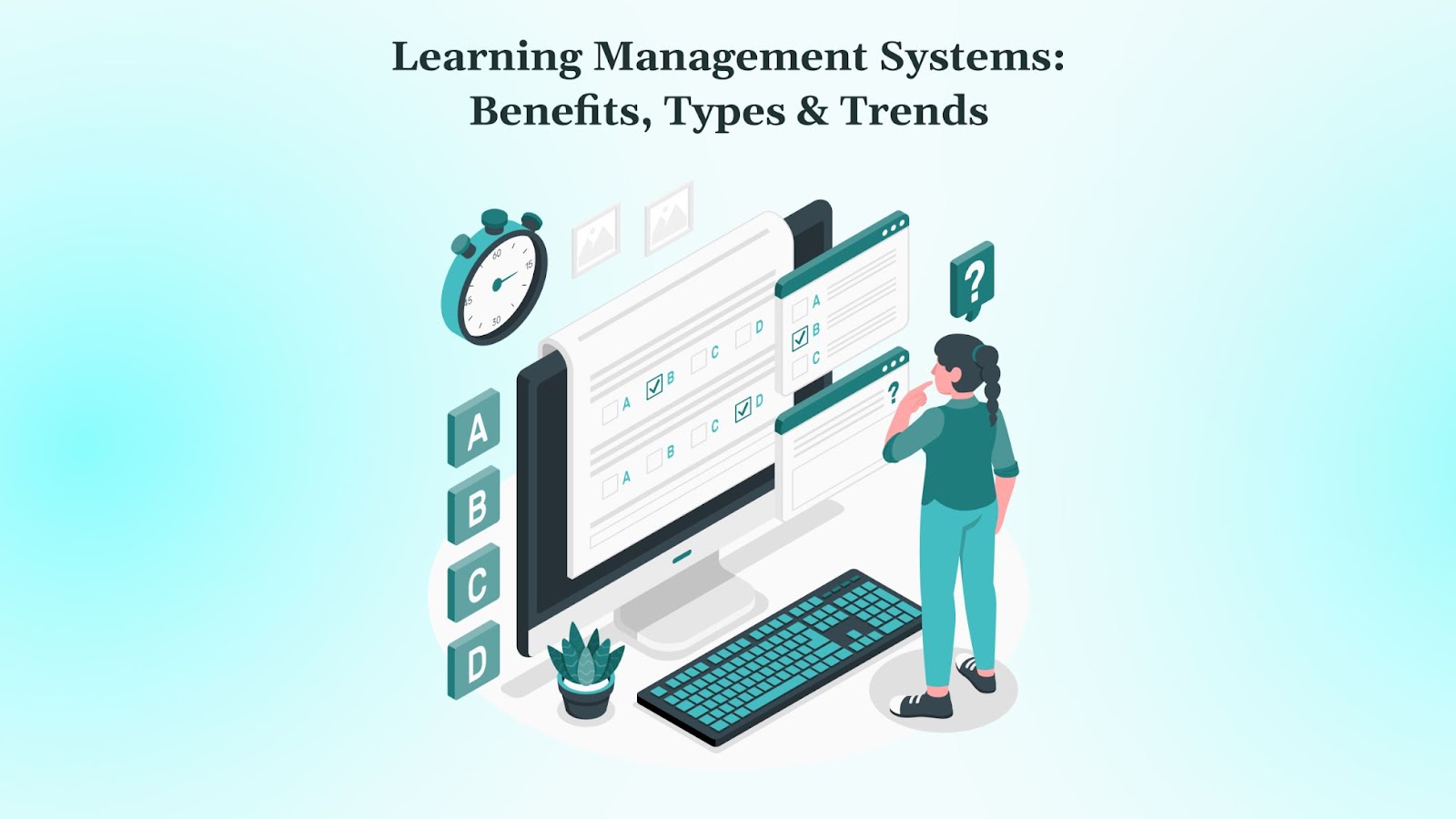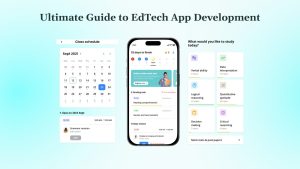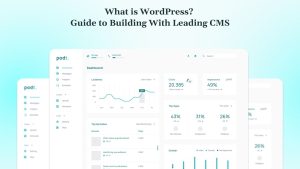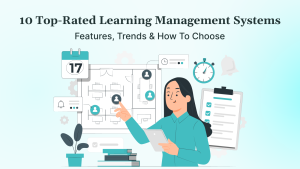As organizations and schools adapt to digital transformation, the demand for efficient and scalable learning solutions is increasing rapidly. Learning Management Systems (LMS) have become a key tool for delivering structured training and education. They offer a single platform to create courses, track learner progress, and manage assessments.
It is no wonder the global LMS market is projected to touch USD 51.9 billion by 2028. This shows how important these platforms have become in shaping the future of education and workplace training.
This blog will walk you through the benefits, types, and latest trends in LMS development. It will show you how these platforms are evolving to keep up with the technology-driven space.
Key Takeaways:
- A Learning Management System (LMS) enables organizations to manage, deliver, and track training programs in one centralized platform.
- Businesses use LMS platforms for employee training, compliance, and customer education, while schools rely on them as digital classrooms supporting online, in-person, and blended learning.
- LMS platforms simplify administration, automate tracking, support personalized learning paths, and ensure compliance through progress monitoring and certification management.
- Benefits include cost efficiency, accessibility anytime/anywhere, scalability for growing teams, and data-driven reporting that improves learning outcomes.
What is a Learning Management System (LMS)?
A Learning Management System (LMS) is a software platform that helps organisations create, manage, deliver, and track training programmes. It centralises learning—making it easier to upload content, enrol users, assign courses, and evaluate progress through quizzes, reports, and completion metrics.
Think of it as the hub where learning lives. For example, a bank may use an LMS to train employees on compliance and KYC policies, while a university might use it to host semester courses, assignments, and online examinations. The purpose remains the same—structured learning, tracked and managed in one place.
Knowing how an LMS functions sets the stage for comparing it with other learning platforms, such as TMS and LEP, to see how each serves different needs.
LMS vs TMS vs LEP
When exploring learning and training technologies, you need to understand the differences between Learning Management Systems (LMS), Training Management Systems (TMS), and Learning Experience Platforms (LEP). Each one serves a different purpose and is designed to meet different organizational needs.
| Features | LMS (Learning Management System) | TMS (Training Management System) | LEP (Learning Experience Platform) |
| Focus | Content management and delivery | Training logistics and scheduling | Personalized, continuous learning |
| Primary Use | Course delivery, assessments, compliance | Resource management, scheduling | Engaging, self-directed learning |
| Audience | Employees, students | Training coordinators, administrators | Learners, managers, organizations |
| Key Benefits | Structured learning, progress tracking | Efficient training operations | Enhanced learner engagement, social learning |
| Learning Approach | Formal, structured learning | Operational, process-driven | Informal, collaborative, self-paced |
| Integration with Other Tools | Typically integrates with other tools for content creation and reporting | Primarily integrates with scheduling and resource tools | Integrates with content sources, social platforms, and personalized learning paths |
| Engagement | Moderate (focused on assessments and certifications) | Low (focused on scheduling and logistics) | High (emphasizes engagement and learner autonomy) |
In simple terms: Choose an LMS when the goal is delivering structured courses at scale, a TMS when training logistics and coordination are the priority, and an LEP when you want personalised learning journeys with flexibility and content discovery.
Ready to create an LMS that balances structure, engagement, and scalability? At DEVtrust, we craft solutions to fit your organization’s unique needs. Schedule a consultation with us to see how we can help you design an LMS that suits your organizational needs.
Now that you’ve grasped the key differences, let’s explore why an LMS is crucial for organizational success and the benefits it brings.
Top Benefits of Using an LMS
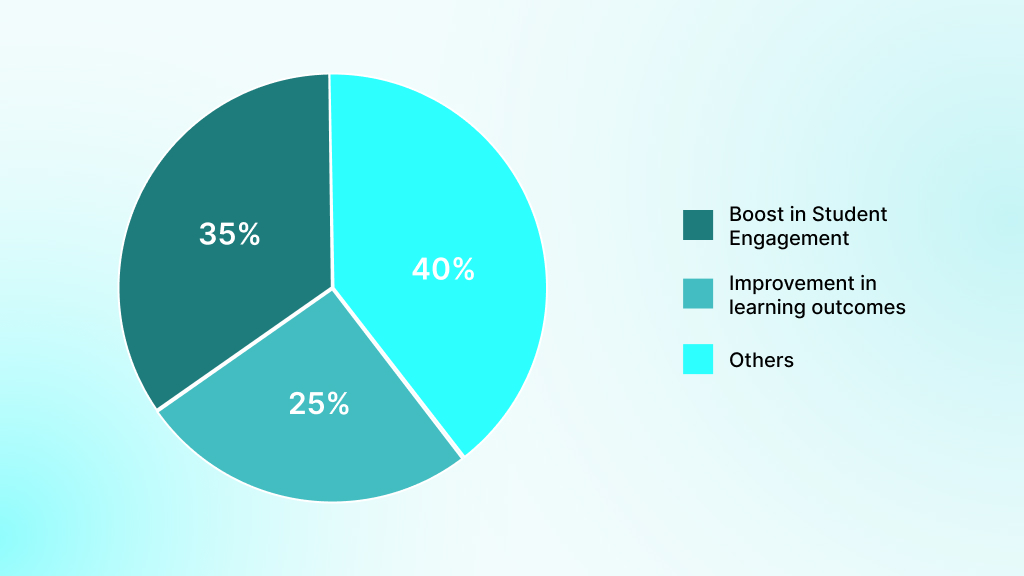
As the demand for continuous learning grows, a Learning Management System (LMS) offers a structured way to manage, deliver, and monitor training activities across teams and institutions. Here’s why organizations rely on LMS today:
- Cost Efficiency: Reduce expenses associated with physical training, such as venues, travel, and instructor-led sessions. Digital content can be reused, updated, and scaled efficiently.
- Accessibility and Flexibility: Learners can access training anytime, anywhere. Ideal for remote teams, global organisations, or hybrid learning environments.
- Scalability: Easily onboard new learners and add fresh content as the organisation expands, without heavy operational overhead.
- Comprehensive Tracking and Reporting: Monitor course progress, completion rates, and assessments with built-in analytics. Supports compliance-heavy industries by maintaining training records.
- Personalized Learning Paths: LMS platforms allow employees and students to access customized learning experiences based on their roles, interests, or career goals, boosting engagement and retention.
- Promotes a Culture of Continuous Learning: By offering on-demand resources and courses, an LMS helps promote an environment of ongoing learning, helping employees take control of their professional development.
Case Study: DEVtrust’s AI-powered LMS, EdTech AI, shows how technology can truly transform learning. For one EdTech platform, it boosted student engagement by 35% and improved learning outcomes by 25%. The platform achieved this by reducing manual tasks and delivering personalized learning paths that kept students more involved.
- Increased Learner Engagement: Interactive elements, such as quizzes, multimedia, and gamification, make learning more enjoyable and effective, leading to better outcomes and higher participation rates.
- Simplified Administration: Automating tasks like course enrollment, progress tracking, and certification management reduces administrative workload, allowing HR and training teams to focus on strategic goals.
A well-implemented LMS simplifies training delivery, elevates engagement, and supports continuous development—making it a strong foundation for organizational learning at scale. With that understanding, let’s explore LMS use cases and how different teams benefit from it.
What are Learning Management Systems Used For?
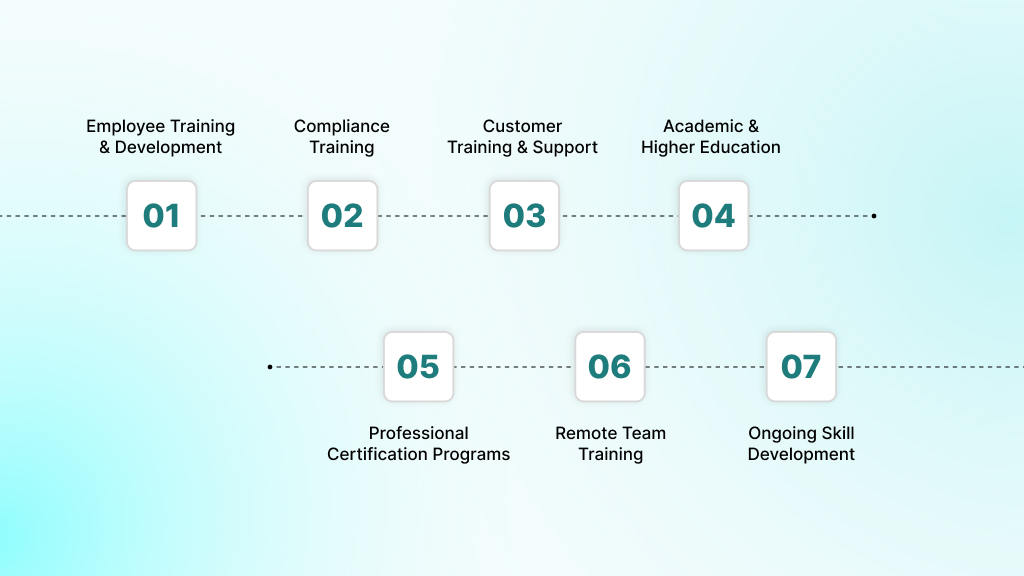
A Learning Management System (LMS) is a flexible tool used across industries to manage, deliver, and track training programs. Here are some of the key ways an LMS is used in different contexts:
Employee Training and Development
An LMS helps organizations simplify employee training programs, making sure teams have the skills they need to perform effectively. It delivers training materials like videos, e-learning modules, and quizzes in one place.
It also tracks progress, identifies skill gaps, and supports personalized learning paths, helping companies build a culture of continuous growth and improvement.
Compliance Training
In industries like healthcare, finance, or manufacturing, compliance training is a must. An LMS ensures employees complete required courses on time and stay updated with changing regulations.
Features like automated reminders, scheduling, and detailed reporting make it easier to maintain compliance records and show proof of adherence during audits.
Customer Training and Support
Many businesses use an LMS to train their customers so they can get the most out of a product or service. For example, software companies often provide tutorials, webinars, or certification programs through an LMS.
The system can even track customer progress and introduce new learning opportunities as products develop.
Academic and Higher Education
Schools and universities rely on LMS platforms to deliver course content, manage assignments, and evaluate performance. Teachers can upload lessons, create quizzes, and interact with students through discussions and collaborative tools.
The system also simplifies grade tracking, attendance, and administrative tasks. Plus, it supports blended learning, giving students the flexibility to combine in-class sessions with online study.
Professional Certification Programs
Professional bodies and industry associations often turn to an LMS to run certification programs in fields like IT, healthcare, or project management. It provides a structured platform for course delivery, assessments, and issuing certifications.
Training for Remote or Distributed Teams
With remote work on the rise, an LMS makes it easy to deliver training to employees regardless of location. Cloud-based platforms ensure that anyone with an internet connection can access training materials.
Continuous Learning and Skill Development
An LMS is not limited to onboarding or compliance. It also supports ongoing learning. Employees can explore libraries of courses and resources to keep up with new technologies, industry changes, and best practices.
With its ability to support continuous learning and skill development, it is clear that LMS platforms can benefit various users across organizations.
Knowing what LMS platforms can do is one thing, but understanding who can benefit from them is essential.
Who Can Make the Most of an LMS?
A Learning Management System (LMS) is a versatile tool that serves organizations across many industries. By centralizing learning and training, it simplifies processes, boosts performance, and scales easily as needs grow. Here is a look at who can benefit from an LMS:
1. Businesses in AI/ML and Tech-Driven Industries
An LMS can be a game-changer for companies in fields like AI/ML and technology. It helps teams grasp complex concepts, such as machine learning models, data analysis techniques, and AI-driven decision-making through structured training. LMS helps in:
- Staying Updated: Developers and data scientists can use an LMS to stay updated on the latest frameworks, tools, and best practices. This ensures teams are continuously learning and adapting to new technologies.
- Onboarding New Hires: In industries that evolve quickly, onboarding needs to be efficient. An LMS provides new employees with access to coding standards, project guidelines, and essential resources, all in one place.
2. Educational Institutions (EdTech)
EdTech LMS platforms bring personalized and flexible learning experiences to schools, colleges, and universities. LMS helps:
- Teachers and Instructors: An LMS makes it easier to deliver interactive lessons, manage assignments, and track student performance. It centralizes course content, simplifying management for large classes while ensuring students meet learning objectives.
- Students: Learners benefit from access to a wide range of materials at their own pace, boosting engagement and retention. Collaboration tools also make the experience more dynamic by connecting students with peers and instructors.
3. Financial Institutions and FinTech Companies
In FinTech, where regulations and technologies shift rapidly, an LMS helps organizations stay compliant and informed. LMS helps in:
- Compliance Training: An LMS simplifies mandatory compliance training by tracking certifications and providing detailed reporting, crucial in a highly regulated sector.
- Continuous Learning: Teams can stay updated on evolving financial products, new services, and industry trends through ongoing LMS-based training.
4. Healthcare Providers and Medical Institutions
For healthcare organizations, an LMS is essential in ensuring quality care, continuous education, and compliance. It helps:
- Medical Professionals: Doctors, nurses, and staff can use an LMS to stay current with medical advancements, treatment protocols, and compliance standards.
- Compliance and Certification: Healthcare providers rely on an LMS to manage training for regulations such as HIPAA, ensuring staff remain certified and qualified.
5. Logistics and Supply Chain Organizations
In logistics, an LMS strengthens training for operational efficiency and safety. It helps:
- Warehouse Staff: Employees can learn about safety procedures, inventory systems, and the latest technologies used in warehouses and distribution centers.
- Truck Drivers and Fleet Managers: An LMS makes it easy to train and track drivers on routes, compliance standards, and safety practices while monitoring certifications and performance.
6. Real Estate Companies
Real estate firms use LMS platforms to keep their agents, brokers, and staff ahead of the curve. LMS helps:
- Agents and Brokers: Training on market trends, legal regulations, sales strategies, and property management tools ensures professionals remain competitive. Interactive courses and certifications further enhance their skills.
- Property Managers and Admin Staff: An LMS helps property managers build expertise in tenant management, leasing regulations, and operational best practices, ensuring teams can handle the dynamic demands of real estate.
Also Read: A Complete Guide To Custom LMS Software Development In 2025
Now that we understand who benefits from LMS, let’s explore how these platforms operate behind the scenes to deliver seamless learning experiences.
How Does an LMS Actually Work?
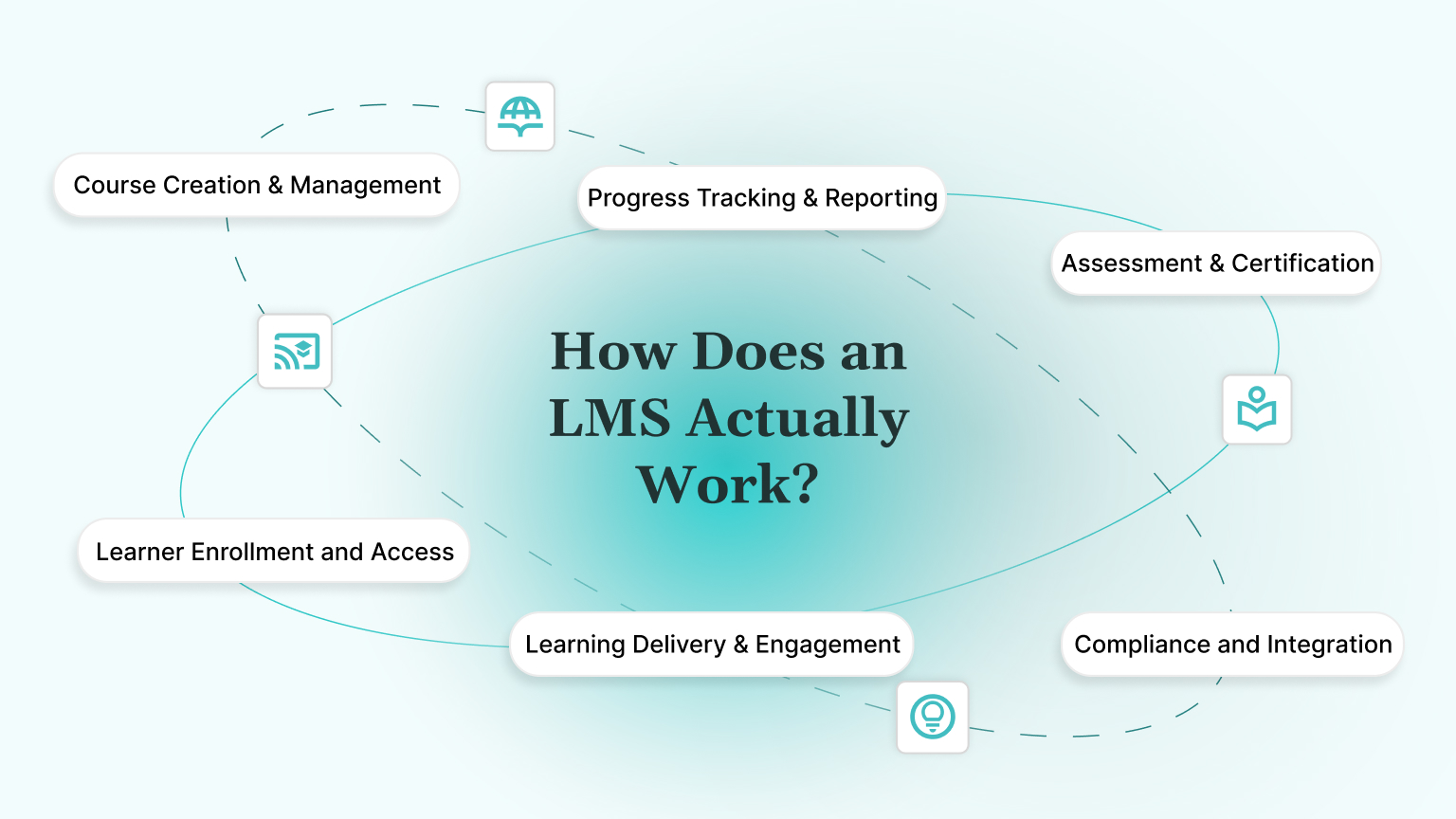
A Learning Management System (LMS) is a software platform that helps organizations manage, deliver, and track training programs and educational content. Below is a breakdown of how an LMS improves the learning experience for both administrators and learners.
1. Course Creation and Content Management
An LMS makes it easy for administrators, trainers, or educators to create and manage training programs. It helps with:
- Content Upload: Different types of content, like videos, presentations, PDFs, quizzes, and interactive modules, can be uploaded and neatly organized into courses or learning paths.
- Course Design: Instructors can structure courses in a clear, step-by-step format, breaking down complex topics into smaller, easy-to-digest modules. Many LMS platforms also provide ready-made templates, assessments, simulations, and multimedia tools to make the content more engaging.
2. Learner Enrollment and Access
Getting learners into the right courses is simple with an LMS. It helps with:
- Enrollment: Learners can be added manually, automatically assigned based on criteria like role or department, or even self-enroll in courses they are interested in.
- Access Control: The system ensures only authorized users see the right content, depending on their role, organization, or location. This way, learning stays relevant and secure.
3. Learning Delivery and Engagement
Once courses are set up and learners are enrolled, the LMS interactively delivers the content. It helps with:
- Content Delivery: Learners can access training through a user-friendly interface. Materials often include videos, slideshows, discussions, and quizzes.
- Gamification and Interaction: Features like quizzes, badges, certificates, and leaderboards add an element of fun, encouraging learners to stay motivated and finish their courses.
- Mobile Learning: Most LMS platforms are mobile-friendly, allowing learners to access content anytime, anywhere on a laptop, tablet, or smartphone.
4. Progress Tracking and Reporting
Tracking progress is one of the biggest strengths of an LMS. It helps with:
- Learner Performance: The system records course completions, test scores, time spent on modules, and more, helping learners see how they are doing and where they can improve.
- Reporting and Analytics: Administrators get access to detailed reports on engagement, completion rates, and performance trends. These insights help organizations improve their training programs and close knowledge gaps.
5. Assessment and Certification
An LMS delivers learning, and also measures and validates it. LMS helps with:
- Assessments: From quizzes and assignments to surveys and exams, assessments help confirm whether learners have understood the material.
- Certification: On completing a course, learners can earn certificates or digital badges, which are especially valuable in compliance-driven industries where employees need to prove their qualifications regularly.
6. Compliance and Integration
For organizations that operate in regulated industries, an LMS ensures training stays on track and integrates smoothly with other systems. It helps with:
- Compliance Tracking: Automated reminders, progress checks, and reporting tools help ensure employees complete mandatory training on time.
- Integrations: Many LMS platforms connect with HR systems, CRM software, or performance tools, creating a smooth flow of information and reducing administrative work.
Beyond integration capabilities, LMS platforms come in various types that meet different needs and learning goals.
Now that you understand the inner workings of an LMS, let’s look at the various types of systems available to suit different needs.
Different Types of Learning Management Systems
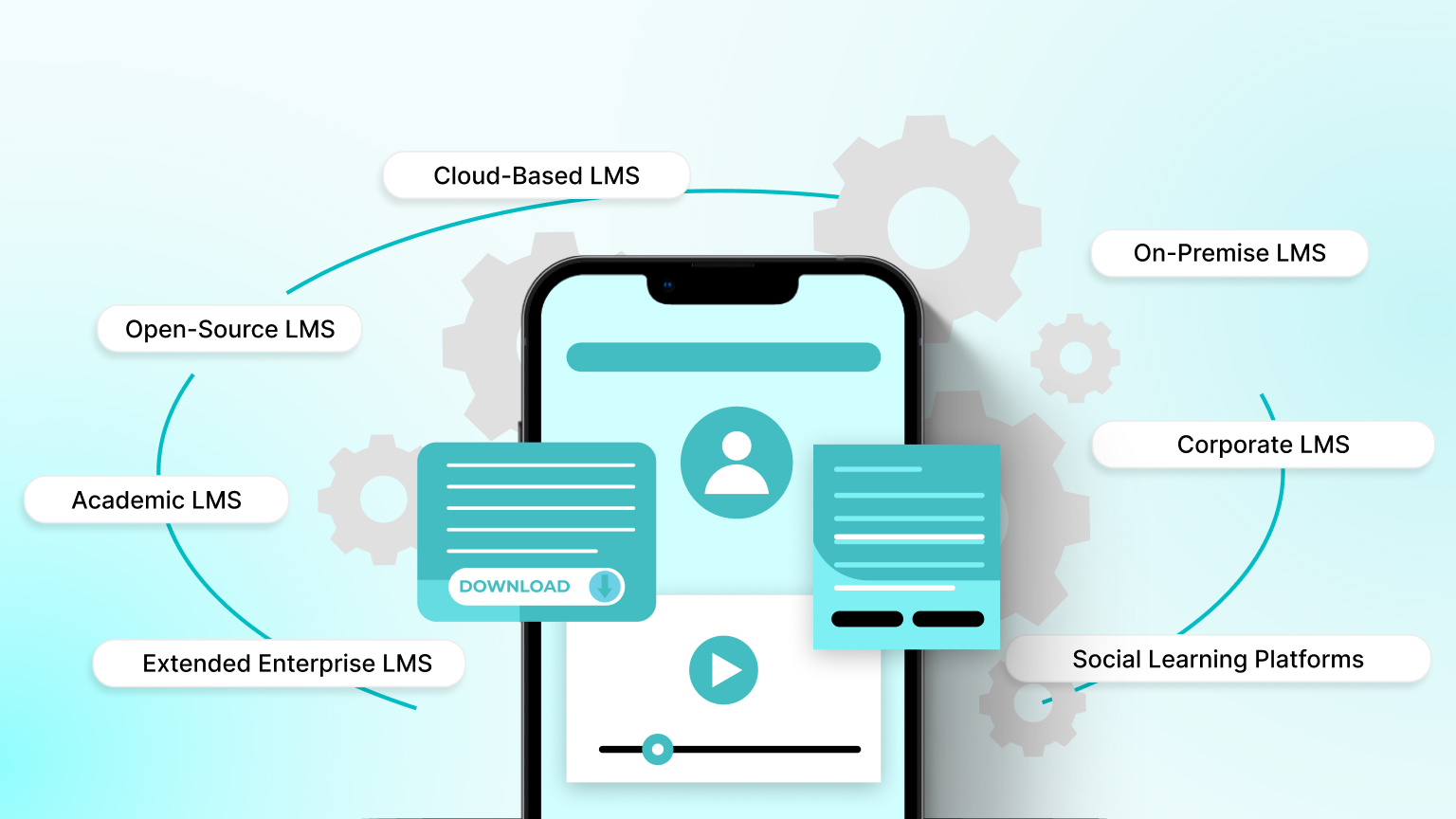
The right choice of LMS often depends on factors like the size of the organization, the complexity of the training, and the kind of learners it is meant for. Below are the different types of LMS.
1. Cloud-Based LMS
A cloud-based LMS is hosted on the vendor’s servers and accessed over the internet. It has become one of the most popular types of LMS because of its accessibility, scalability, and cost-efficiency. Key features include:
- Easy to scale to support any number of users.
- Accessible from anywhere, making it an excellent fit for remote or globally dispersed teams.
- No investments required in internal infrastructure or hardware.
- Updates and maintenance are handled by the vendor, keeping the system up to date.
Cloud-Based LMS is best for businesses, educational institutions, and organizations looking for a flexible, low-maintenance solution that can grow with them. It is also useful for companies with remote or distributed workforces.
2. On-Premise LMS
An on-premise LMS is installed and managed on an organization’s own servers. Since everything is hosted internally, it offers greater control over data security and customization. Key features include:
- Complete control over data security and privacy.
- Can be tailored to meet organizational needs, including system integrations.
- Requires higher upfront investment in hardware, software, and ongoing maintenance.
On-Premise LMS is best for large enterprises, particularly in regulated sectors like healthcare, finance, or government, where data security and customization are top priorities.
3. Open-Source LMS
An open-source LMS is community-driven and free to use. Since the source code is available, you can modify it to fit your unique requirements. Key features include:
- Free to access, though costs may arise for development and customization
- Highly customizable to match specific learning needs
- Supported by a wide community offering plugins, add-ons, and shared resources
An open-source LMS is best for organizations with strong technical resources to build and maintain a tailored solution. It is a cost-effective choice for those with unique training needs or smaller businesses aiming to avoid high licensing fees.
4. Corporate LMS
A corporate LMS is designed with businesses in mind. It supports employee training, compliance programs, onboarding, and professional development, with a strong emphasis on tracking and reporting. Key features include:
- Smooth integration with HR and performance management systems.
- Scalable enough to handle large employee groups.
- Focuses on compliance, certifications, and continuous skill-building.
- Advanced reporting and analytics to measure effectiveness.
Corporate LMS is best for large organizations and enterprises that require ongoing employee training, structured onboarding, and compliance monitoring.
5. Academic LMS
An academic LMS caters to schools, colleges, and universities. It offers a platform for students to access course materials, collaborate, and submit assignments. Key features include:
- Delivery support of video lectures, reading materials, and assignments.
- Communication tools such as chats and discussion boards.
- Integrated grading and reporting systems.
- Collaboration features for group projects and peer learning.
Academic LMS is best for K–12 schools, higher education institutions, and vocational programs seeking a comprehensive system for teaching, student engagement, and assessment.
6. Extended Enterprise LMS
An extended enterprise LMS is built to train external audiences like customers, resellers, or partners. It helps organizations deliver consistent training beyond their internal teams. Key features include:
- Multi-user management with different access levels.
- Customizable branding and tailored course content for external users.
- Integrates with CRM and ERP systems for smooth external user management.
- Scalable for large or global audiences.
Extended Enterprise LMS is best for companies with a broad external network that need to train customers, partners, or resellers. It is especially useful for product training, certifications, and ensuring consistent knowledge across regions.
7. Social Learning Platforms (LEP)
A Learning Experience Platform (LEP) takes a more collaborative approach to learning. It emphasizes interaction, knowledge sharing, and community-driven growth over traditional course delivery. Key features include:
- Collaboration and peer-to-peer learning.
- Integration with social media and networking platforms.
- User-generated content and shared experiences.
- Personalized recommendations based on learner behavior and preferences.
A Learning Experience Platform (LEP) is best for organizations focused on social learning and continuous development. LEPs are particularly effective in industries like AI/ML, EdTech, and real estate, where collaboration and knowledge sharing play a big role in success.
As you have understood the benefits of LEPs, it is a good time to look at the essential features that make an LMS valuable for any organization.
Must-Have Features in an LMS
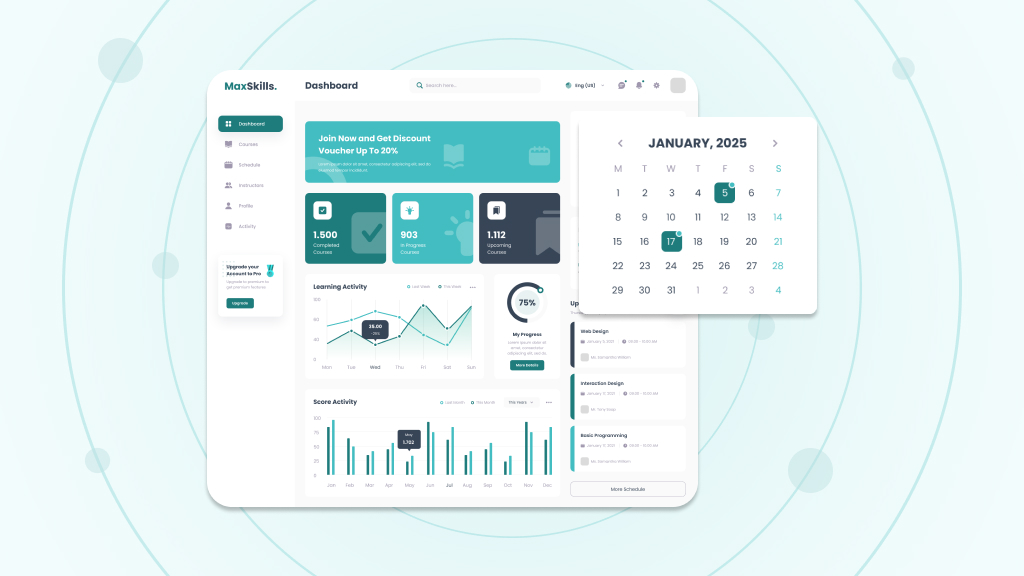
A Learning Management System (LMS) is a platform that helps organizations create, manage, and deliver educational content in one place. It acts as a central hub for all learning activities, making it easier to organize training while keeping learners engaged.
Modern LMS platforms usually come with a variety of features that support both administrators and learners. Below is a list of those features.
Analytics and Reporting
Modern LMS platforms come with built-in analytics and reporting tools that make it easier for administrators to track course performance. These tools provide insights into learner engagement, completion rates, and overall training effectiveness.
With this data, organizations can fine-tune their learning strategies for better results. Some systems even integrate with CRMs and other business tools to measure training ROI and its impact on metrics like sales performance.
Mobile Capabilities
A good LMS allows learners to log in from smartphones or tablets and continue their training anytime, anywhere. This flexibility not only improves accessibility but also boosts engagement. In fact, studies show that around one-third of companies now include mobile learning (mLearning) as part of their training strategy.
Gamification
Adding game-like features can make learning more fun and engaging. Through elements like points, badges, competitions, and simulations, gamification encourages learners to stay motivated and complete courses.
It taps into people’s natural enjoyment of challenges and rewards, leading to better participation and outcomes.
Customer Support
Even with the most intuitive LMS, questions or issues are bound to arise. That is why reliable customer support is an essential feature.
The best platforms provide multiple support channels, such as live chat, phone, or email, so administrators and learners can quickly resolve problems and avoid unnecessary downtime.
Third-Party Integrations
An LMS should fit smoothly into your organization’s existing workflows. Strong integration capabilities allow the system to connect with tools like video platforms, content creation software, or HR and talent management systems.
These integrations make it easier to create engaging courses and streamline processes like onboarding.
Support for Multiple Content Formats
A versatile LMS supports a wide range of content types, including videos, presentations, audio files, webinars, and downloadable resources.
Some advanced platforms even offer VR/AR capabilities for immersive training experiences. Offering multiple formats keeps learning fresh and accessible.
AI and Personalization
Artificial intelligence is transforming how LMS platforms deliver training. By analyzing user data, AI can recommend personalized learning paths, generate course content, and tailor recommendations to each learner’s needs.
This creates a more relevant and engaging experience, ensuring that learners focus on what matters most to them.
SCORM and Tin Can (xAPI) Compliance
To ensure compatibility and easy tracking, many LMS platforms support SCORM or Tin Can API standards. SCORM requires content to be created in external tools and uploaded, while newer systems with built-in authoring capabilities allow teams to create courses directly in the LMS. This simplifies content development and saves time.
Co-Authoring Functions
Training content often requires input from multiple experts. An LMS with co-authoring functionality allows teams to collaborate on course creation in real time. This improves efficiency and makes sure that the final course reflects a wide range of expertise.
Instant Feedback Functions
Timely feedback is key to improving training. Instead of waiting until the end of a course, some LMS platforms allow learners to share feedback instantly during the learning process.
This real-time input helps instructors make quick adjustments and deliver a better learning experience.
Want to integrate advanced features like gamification, AI-driven personalization, and detailed analytics in your LMS?
DEVtrust offers specialized LMS development services to help you create a platform that keeps learners engaged and supports business growth.
Reach out to us to start designing your custom LMS.
With the key features in mind, let’s walk through how to choose the right LMS for your needs and set it up for success.
How to Select the Right LMS?
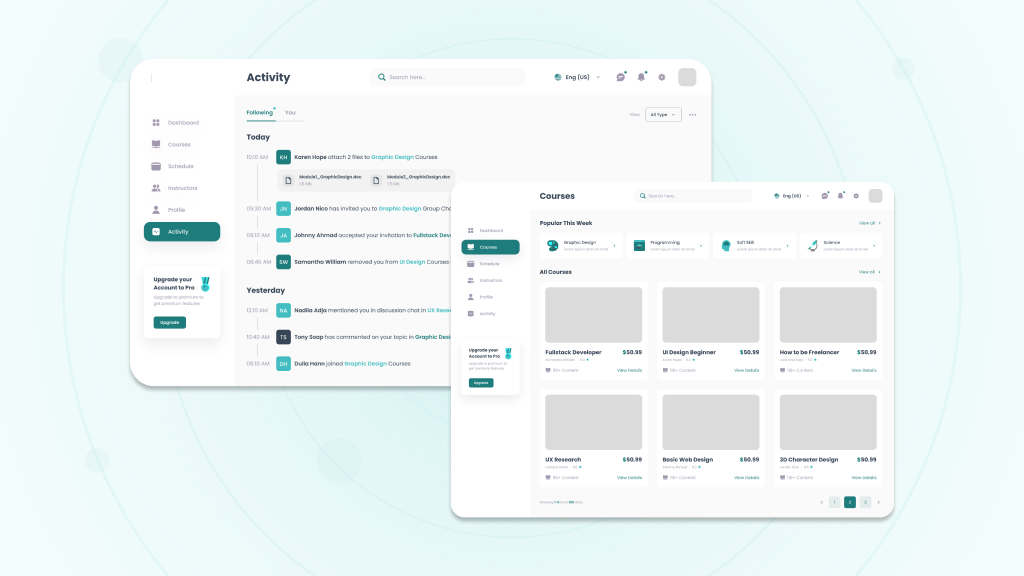
A Learning Management System (LMS) plays a vital role in helping organizations improve training, ensure compliance, and create better learning experiences. The most effective LMS platforms go beyond just delivering courses.
They combine powerful features, flexibility, and ease of use to support both learners and administrators. Here are some of the factors you need to consider while selecting the best LMS solutions:
User-Friendly Interface
The best LMS platforms are designed to be intuitive for both learners and administrators. A clean and simple interface makes it easy to go through courses, assignments, and reports without the hassle of a steep learning curve.
They also allow customization so organizations can align the look and feel with their own branding, including logos, colors, and layouts.
Scalability
As organizations grow, training needs naturally expand. A scalable LMS can handle more learners, courses, and content without requiring heavy investments or technical challenges.
Flexible licensing options make it easier for both small businesses and large enterprises to scale up (or down) as needed.
Mobile Compatibility
Today’s learners expect the convenience of mobile access. The best LMS platforms are mobile-responsive, ensuring training can be accessed anytime, anywhere, from a phone or tablet.
Many also provided dedicated apps for iOS and Android, giving learners a smooth, optimized mobile experience, perfect for remote teams or employees on the move.
Comprehensive Reporting and Analytics
Strong reporting features help administrators track engagement, measure course effectiveness, and calculate training ROI. These insights make it easier to refine learning strategies and achieve goals.
For industries with compliance requirements, automated reports can track certifications, prove regulatory adherence, and simplify audits.
Integration with Third-Party Tools
A strong LMS connects seamlessly with other systems like HR software, CRMs, payroll, or video conferencing platforms. This smooth flow of data reduces duplication, saves time, and improves overall efficiency.
Some platforms also integrate with content libraries and providers, giving organizations instant access to a wide variety of ready-to-use learning materials.
Personalized Learning Paths
The best LMS platforms let organizations design personalized learning paths tailored to roles, interests, or performance.
Advanced systems even use adaptive learning technology to adjust content and pacing based on individual progress, ensuring a truly customized learning experience.
Collaboration and Social Learning Features
Learning is more engaging when it is social. Discussion boards, peer-to-peer collaboration, and real-time chat functions help learners connect, share ideas, and solve problems together.
Collaborative tools also make group projects and peer feedback possible, encouraging teamwork and knowledge sharing.
Security and Data Protection
Protecting learner and organizational data is non-negotiable. The best LMS platforms use encryption, multi-factor authentication, and security updates to keep information safe.
They also comply with regulations like GDPR, HIPAA, and other industry standards to ensure data is managed responsibly.
Support for Multiple Content Formats
Different learners absorb knowledge in different ways. Leading LMS platforms support a wide range of content, like videos, PDFs, presentations, simulations, and webinars, giving organizations flexibility in how they deliver training.
Some advanced systems even include VR and AR features, making complex training more immersive and effective.
Ease of Use for Administrators
A great LMS benefits learners and also makes life easier for administrators. Features like automatic enrollments, reminders, and certification management cut down on repetitive tasks.
Customizable dashboards give admins quick visibility into learner progress, course performance, and training needs across the organization.
Selecting the right LMS is crucial to your success. Let DEVtrust guide you in choosing and developing the perfect LMS solution tailored to your business needs.
While these features make administration easier, it is also important to be aware of the challenges that can come with using an LMS and how to address them effectively.
Challenges of Using an LMS & Ways to Tackle Them
While a Learning Management System (LMS) can bring tremendous value to training and development, implementing it is not always simple. From setup to ongoing upkeep, organizations often encounter challenges that can impact the ability of the system to deliver on its promise.
Here are some of the most common hurdles companies face when implementing and maintaining an LMS:
| Challenges | Solutions |
| Complexity of Implementation | Plan thoroughly, involve IT experts, and choose an LMS with easy integrations. |
| User Adoption and Resistance | Provide training, highlight benefits, and involve users early in the process. |
| Ongoing Maintenance and Content Updates | Assign a team for regular updates and system checks. |
| Data Security and Privacy Concerns | Choose an LMS with strong security features and regulatory compliance (e.g., GDPR, HIPAA). |
| Scalability and Growth Management | Opt for a scalable LMS with flexible infrastructure for future growth. |
| Cost of Implementation and Maintenance | Select a cost-effective LMS, and evaluate long-term ROI. |
| Limited User Engagement | Use gamification, personalized learning paths, and interactive content. |
| Technical Support and Troubleshooting | Ensure reliable customer support and create an internal troubleshooting guide. |
| Compliance and Certification | Choose an LMS with automated compliance tracking and certification reminders. |
Understanding these challenges provides perspective on how LMS technology continues to evolve to better meet organizational needs.
Also Read: How to Develop AI Software: A Complete Guide
How DEVtrust Helps You Build the Right LMS
Most LMS platforms start with good intent but end up as content warehouses—low adoption, poor reporting, messy integrations, and constant admin work for L&D and HR. Add compliance pressure, multiple learner groups, and fragmented tools, and it becomes hard to prove the real impact of learning on performance and business outcomes.
DEVtrust helps you design, build, or modernise an LMS learning management system that fits your workflows, integrates cleanly with your existing stack, and is engineered for engagement, compliance, and scale from day one.
- Built Around Your Use Cases: We shape LMS architecture around your real scenarios—onboarding, compliance, skills academies, sales enablement, partner and customer training—instead of forcing everything into generic course structures.
- AI-Driven Personalisation and Analytics: We embed recommendation engines, adaptive learning paths, and deep analytics so you can track skills, compliance, and performance instead of just course completion.
- Enterprise-Ready Integrations & Security: We integrate your LMS with HRIS, SSO, CRM, collaboration tools, and content libraries while engineering role-based access, encryption, and compliance (GDPR, HIPAA, industry standards) into the core.
- Custom Features for Your Learners: From mobile-first learning and microlearning flows to gamification, certifications, and LEP-style experiences, we tailor the LMS to how your employees, customers, and partners actually learn.
- End-to-End Delivery & Support: We support you across discovery, vendor/stack selection, custom development, migration, rollout, and continuous improvement so the LMS remains reliable, current, and easy to run.
With DEVtrust, your LMS becomes an engine for engagement, compliance, and capability building, not just another system your teams struggle to adopt.
What is Next for LMS Technology?
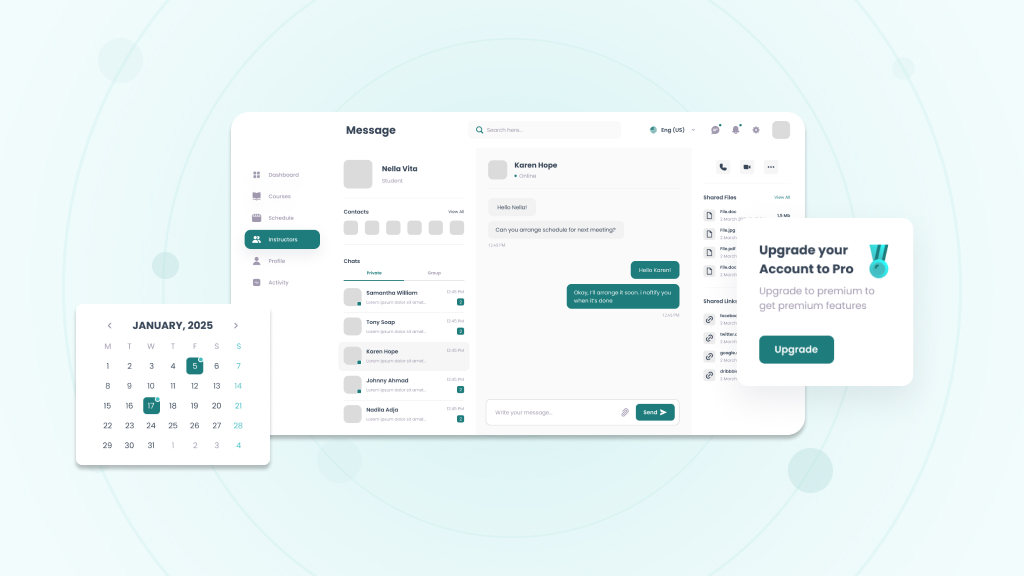
Learning Management Systems (LMS) are changing quickly, which is driven by new technologies and evolving learning approaches. To stay ahead, businesses should focus on the trends shaping the future of LMS. Here are some of the most important developments to watch:
Artificial Intelligence (AI) and Personalization
AI is set to transform learning by making it more personal. Modern LMS platforms will use AI to design adaptive learning paths based on each learner’s progress, preferences, and performance.
AI will also help recommend courses and resources by analyzing past activities, ensuring that training supports both personal goals and organizational objectives.
Mobile Learning (mLearning)
With mobile devices now at the center of digital life, mobile learning will continue to grow. LMS platforms are becoming mobile-first, offering smooth access through apps and responsive interfaces.
Features like offline access will make learning even more convenient, allowing users to download materials and keep progressing without an internet connection.
Gamification and Immersive Learning
Gamification will play a bigger role in keeping learners motivated. Elements like points, badges, leaderboards, and challenges will make courses more interactive and enjoyable, driving higher completion rates.
At the same time, technologies such as Virtual Reality (VR) and Augmented Reality (AR) will create immersive environments for practical or complex training.
Social and Collaborative Learning
Future LMS platforms will include features like forums, peer reviews, and group projects to encourage collaboration. Integration with platforms like Slack or Microsoft Teams will further blend learning into daily workflows, making knowledge-sharing seamless and natural.
Microlearning
Short, focused learning modules will take center stage. LMS platforms will increasingly deliver bite-sized content like video snippets, infographics, and quick quizzes, making it easier to absorb and retain knowledge.
Microlearning also supports “just-in-time” learning, where learners access exactly what they need in the moment, improving productivity and practical application.
Data-Driven Learning Analytics
Advanced analytics will give organizations a clearer picture of learner behavior, engagement, and performance. Predictive analytics will go a step further, using past data to suggest the most effective learning paths and resources.
Integration with Other Enterprise Systems
Future LMS platforms will not exist in isolation. They will connect with HR, CRM, and other business systems to give a complete view of employee performance, compliance, and career growth.
This integration will also simplify administrative tasks, like enrollment, assignments, and certifications, making learning management more efficient.
Cloud-Based LMS
Cloud-based LMS solutions will remain the go-to choice for organizations. They offer scalability, cost savings, and easy access without the need for heavy infrastructure.
For growing businesses, multi-tenant setups will make it easy to manage multiple departments or clients from a single system, adding flexibility and efficiency.
Learning and Performance Management Integration
LMS platforms will link training directly with performance management, helping organizations measure the impact of learning on real job outcomes. Continuous feedback tools will allow learners to receive insights in real time, making it easier to adjust and improve as they go.
Compliance and Regulatory Training
As regulations tighten globally, LMS platforms will enhance compliance training features. Automated reminders, certification tracking, and region-specific compliance tools will ensure organizations stay aligned with standards.
For global businesses, multi-region compliance tracking will make it easier to manage diverse regulatory requirements across countries.
Wrapping Up
Learning Management Systems (LMS) are transforming the way organizations and educational institutions deliver training and education. It offers the tools to create flexible, scalable, and effective learning experiences.
As technology evolves, keeping up with the latest LMS trends will help you stay ahead and promote continuous learning within your organization or institution.
If you are ready to build an LMS that drives engagement, enhances learning outcomes, and meets your business objectives, DEVtrust is your ideal partner. From initial consultation to full-scale deployment, we ensure your LMS is scalable, reliable, and effective.
Contact us today to take the first step towards building a customized LMS that works for you.

